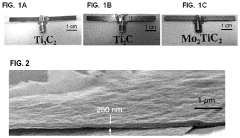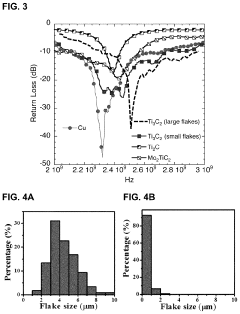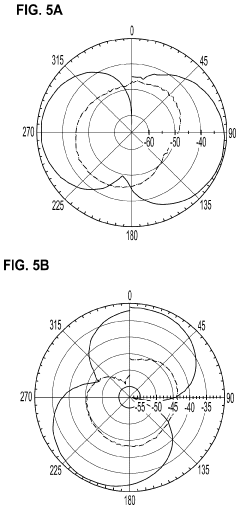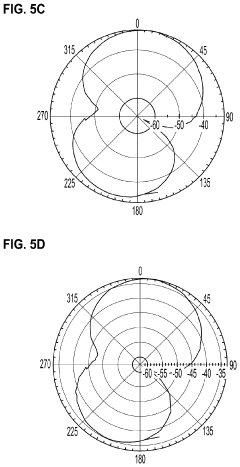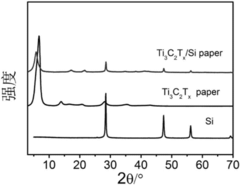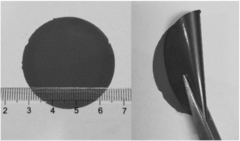MXene Utilization in Quantum Random Number Generation
AUG 11, 20258 MIN READ
Generate Your Research Report Instantly with AI Agent
Patsnap Eureka helps you evaluate technical feasibility & market potential.
MXene QRNG Background
MXene, a class of two-dimensional transition metal carbides and nitrides, has emerged as a promising material for various applications, including quantum random number generation (QRNG). The intersection of MXene and QRNG represents a cutting-edge field that combines advanced materials science with quantum technology, aiming to enhance the security and efficiency of random number generation processes.
The development of MXene materials can be traced back to 2011 when they were first synthesized by selectively etching the A-layer from MAX phases. Since then, MXenes have garnered significant attention due to their unique properties, such as high electrical conductivity, tunable electronic structure, and large surface area. These characteristics make MXenes particularly suitable for integration into quantum devices, including those used for random number generation.
Quantum random number generation is a critical component in various fields, including cryptography, scientific simulations, and secure communications. Traditional random number generators often rely on deterministic algorithms, which can be vulnerable to prediction and manipulation. QRNG, on the other hand, leverages the inherent randomness of quantum mechanical processes to produce truly random numbers, offering a higher level of security and unpredictability.
The utilization of MXene in QRNG systems represents a convergence of two rapidly evolving technological domains. MXenes' unique electronic properties can be harnessed to enhance the efficiency and reliability of quantum random number generators. For instance, the high conductivity and tunable bandgap of MXenes can be exploited to create novel quantum light sources or detectors, which are essential components in many QRNG architectures.
Recent research has focused on exploring various MXene compositions and structures to optimize their performance in quantum applications. The ability to tailor MXenes' properties through chemical modification and nanostructuring offers a wide range of possibilities for fine-tuning their interaction with quantum systems. This adaptability is particularly valuable in the context of QRNG, where precise control over quantum states and measurements is crucial.
As the field progresses, researchers are investigating ways to integrate MXene-based components into existing QRNG platforms, as well as developing entirely new QRNG architectures that leverage MXene's unique properties. The potential benefits include improved generation rates, enhanced resilience to environmental disturbances, and increased scalability of QRNG devices.
The ongoing exploration of MXene utilization in QRNG is part of a broader trend towards the development of quantum-enhanced technologies. As quantum computing and quantum communication systems continue to advance, the demand for high-quality random numbers is expected to grow, further driving innovation in this field. The synergy between MXene materials and QRNG technology holds promise for addressing future challenges in secure information processing and communication.
The development of MXene materials can be traced back to 2011 when they were first synthesized by selectively etching the A-layer from MAX phases. Since then, MXenes have garnered significant attention due to their unique properties, such as high electrical conductivity, tunable electronic structure, and large surface area. These characteristics make MXenes particularly suitable for integration into quantum devices, including those used for random number generation.
Quantum random number generation is a critical component in various fields, including cryptography, scientific simulations, and secure communications. Traditional random number generators often rely on deterministic algorithms, which can be vulnerable to prediction and manipulation. QRNG, on the other hand, leverages the inherent randomness of quantum mechanical processes to produce truly random numbers, offering a higher level of security and unpredictability.
The utilization of MXene in QRNG systems represents a convergence of two rapidly evolving technological domains. MXenes' unique electronic properties can be harnessed to enhance the efficiency and reliability of quantum random number generators. For instance, the high conductivity and tunable bandgap of MXenes can be exploited to create novel quantum light sources or detectors, which are essential components in many QRNG architectures.
Recent research has focused on exploring various MXene compositions and structures to optimize their performance in quantum applications. The ability to tailor MXenes' properties through chemical modification and nanostructuring offers a wide range of possibilities for fine-tuning their interaction with quantum systems. This adaptability is particularly valuable in the context of QRNG, where precise control over quantum states and measurements is crucial.
As the field progresses, researchers are investigating ways to integrate MXene-based components into existing QRNG platforms, as well as developing entirely new QRNG architectures that leverage MXene's unique properties. The potential benefits include improved generation rates, enhanced resilience to environmental disturbances, and increased scalability of QRNG devices.
The ongoing exploration of MXene utilization in QRNG is part of a broader trend towards the development of quantum-enhanced technologies. As quantum computing and quantum communication systems continue to advance, the demand for high-quality random numbers is expected to grow, further driving innovation in this field. The synergy between MXene materials and QRNG technology holds promise for addressing future challenges in secure information processing and communication.
QRNG Market Analysis
The quantum random number generation (QRNG) market is experiencing significant growth driven by the increasing demand for secure encryption and cryptographic applications. As quantum technologies advance, QRNG solutions are becoming more accessible and cost-effective, expanding their potential applications across various industries.
The global QRNG market is projected to grow at a compound annual growth rate (CAGR) of over 20% from 2021 to 2026. This growth is primarily fueled by the rising concerns over data security and the need for robust encryption methods in sectors such as finance, healthcare, and government. The integration of QRNG in IoT devices and 5G networks is also contributing to market expansion.
Financial institutions are among the early adopters of QRNG technology, utilizing it for secure transactions, risk modeling, and fraud detection. The gaming industry is another significant market, employing QRNG for fair and unpredictable outcomes in online gambling and lottery systems. Additionally, the automotive sector is showing interest in QRNG for autonomous vehicle security and V2X communication.
The market landscape is characterized by a mix of established players and innovative startups. Key market players include ID Quantique, Quintessence Labs, and KETS Quantum Security. These companies are continuously investing in research and development to improve QRNG performance and reduce costs.
Geographically, North America and Europe lead the QRNG market due to their advanced technological infrastructure and stringent data protection regulations. However, the Asia-Pacific region is expected to witness the fastest growth, driven by increasing investments in quantum technologies by countries like China and Japan.
Despite the promising growth, the QRNG market faces challenges such as the high cost of implementation and the need for standardization. As the technology matures and economies of scale are achieved, these barriers are expected to diminish, leading to wider adoption across industries.
The potential integration of MXene in QRNG devices presents an exciting opportunity for market growth. MXene's unique properties, such as high conductivity and tunable electronic structure, could enhance the efficiency and reliability of QRNG systems. This innovation may lead to more compact, energy-efficient, and cost-effective QRNG solutions, potentially accelerating market penetration in consumer electronics and IoT devices.
The global QRNG market is projected to grow at a compound annual growth rate (CAGR) of over 20% from 2021 to 2026. This growth is primarily fueled by the rising concerns over data security and the need for robust encryption methods in sectors such as finance, healthcare, and government. The integration of QRNG in IoT devices and 5G networks is also contributing to market expansion.
Financial institutions are among the early adopters of QRNG technology, utilizing it for secure transactions, risk modeling, and fraud detection. The gaming industry is another significant market, employing QRNG for fair and unpredictable outcomes in online gambling and lottery systems. Additionally, the automotive sector is showing interest in QRNG for autonomous vehicle security and V2X communication.
The market landscape is characterized by a mix of established players and innovative startups. Key market players include ID Quantique, Quintessence Labs, and KETS Quantum Security. These companies are continuously investing in research and development to improve QRNG performance and reduce costs.
Geographically, North America and Europe lead the QRNG market due to their advanced technological infrastructure and stringent data protection regulations. However, the Asia-Pacific region is expected to witness the fastest growth, driven by increasing investments in quantum technologies by countries like China and Japan.
Despite the promising growth, the QRNG market faces challenges such as the high cost of implementation and the need for standardization. As the technology matures and economies of scale are achieved, these barriers are expected to diminish, leading to wider adoption across industries.
The potential integration of MXene in QRNG devices presents an exciting opportunity for market growth. MXene's unique properties, such as high conductivity and tunable electronic structure, could enhance the efficiency and reliability of QRNG systems. This innovation may lead to more compact, energy-efficient, and cost-effective QRNG solutions, potentially accelerating market penetration in consumer electronics and IoT devices.
MXene QRNG Challenges
The integration of MXene materials into Quantum Random Number Generation (QRNG) systems presents several significant challenges that researchers and engineers must address. One of the primary obstacles is the optimization of MXene's quantum properties for QRNG applications. While MXene exhibits promising characteristics, such as high conductivity and tunable electronic properties, fine-tuning these attributes to generate truly random quantum states remains a complex task.
Another challenge lies in the fabrication and processing of MXene materials for QRNG devices. The synthesis of high-quality, uniform MXene sheets with consistent quantum properties is crucial for reliable random number generation. However, achieving this level of consistency in large-scale production is currently difficult, potentially limiting the scalability of MXene-based QRNG systems.
The stability and longevity of MXene materials in QRNG devices also pose significant challenges. MXene's susceptibility to oxidation and degradation over time may affect the long-term performance and reliability of QRNG systems. Developing effective encapsulation methods or surface modification techniques to protect MXene from environmental factors is essential for ensuring the durability of MXene-based QRNG devices.
Integration of MXene with existing QRNG architectures presents another hurdle. Adapting current QRNG designs to incorporate MXene materials while maintaining or improving performance requires careful engineering and potentially new device architectures. This integration must also consider compatibility with other components in the QRNG system, such as detectors and signal processing units.
The characterization and validation of MXene-based QRNG outputs pose additional challenges. Developing robust testing methodologies to verify the randomness and quality of generated numbers is crucial for ensuring the security and reliability of MXene QRNG systems. This involves creating new statistical tests and validation protocols specifically tailored to MXene-based quantum random number generators.
Furthermore, the cost-effectiveness of MXene-based QRNG systems compared to existing technologies remains a significant challenge. While MXene offers potential advantages in terms of performance and scalability, the overall production and implementation costs must be competitive with current QRNG solutions to drive widespread adoption.
Lastly, addressing potential quantum decoherence effects in MXene-based QRNG systems is a critical challenge. Maintaining quantum coherence for sufficient durations to generate high-quality random numbers requires innovative approaches to mitigate environmental interactions and noise that can disrupt the quantum states of MXene materials.
Another challenge lies in the fabrication and processing of MXene materials for QRNG devices. The synthesis of high-quality, uniform MXene sheets with consistent quantum properties is crucial for reliable random number generation. However, achieving this level of consistency in large-scale production is currently difficult, potentially limiting the scalability of MXene-based QRNG systems.
The stability and longevity of MXene materials in QRNG devices also pose significant challenges. MXene's susceptibility to oxidation and degradation over time may affect the long-term performance and reliability of QRNG systems. Developing effective encapsulation methods or surface modification techniques to protect MXene from environmental factors is essential for ensuring the durability of MXene-based QRNG devices.
Integration of MXene with existing QRNG architectures presents another hurdle. Adapting current QRNG designs to incorporate MXene materials while maintaining or improving performance requires careful engineering and potentially new device architectures. This integration must also consider compatibility with other components in the QRNG system, such as detectors and signal processing units.
The characterization and validation of MXene-based QRNG outputs pose additional challenges. Developing robust testing methodologies to verify the randomness and quality of generated numbers is crucial for ensuring the security and reliability of MXene QRNG systems. This involves creating new statistical tests and validation protocols specifically tailored to MXene-based quantum random number generators.
Furthermore, the cost-effectiveness of MXene-based QRNG systems compared to existing technologies remains a significant challenge. While MXene offers potential advantages in terms of performance and scalability, the overall production and implementation costs must be competitive with current QRNG solutions to drive widespread adoption.
Lastly, addressing potential quantum decoherence effects in MXene-based QRNG systems is a critical challenge. Maintaining quantum coherence for sufficient durations to generate high-quality random numbers requires innovative approaches to mitigate environmental interactions and noise that can disrupt the quantum states of MXene materials.
Current MXene QRNG Tech
01 MXene synthesis and composition
MXenes are two-dimensional transition metal carbides, nitrides, or carbonitrides with unique properties. They are synthesized through selective etching of MAX phases, resulting in nanosheets with high surface area and conductivity. The composition and structure of MXenes can be tailored for specific applications by controlling the synthesis process and selecting appropriate precursor materials.- MXene synthesis and composition: MXenes are a class of two-dimensional transition metal carbides, nitrides, or carbonitrides. They are synthesized through selective etching of MAX phases, resulting in layered structures with unique properties. The composition and synthesis methods of MXenes can be tailored to achieve specific characteristics for various applications.
- Energy storage applications: MXenes show promising potential in energy storage devices such as supercapacitors and batteries. Their high electrical conductivity, large surface area, and ability to intercalate ions make them suitable for improving the performance of electrodes in these devices. Research focuses on optimizing MXene-based materials for enhanced energy density and cycling stability.
- Electromagnetic interference shielding: MXenes exhibit excellent electromagnetic interference (EMI) shielding properties due to their high electrical conductivity and ability to absorb electromagnetic waves. They can be incorporated into composites or coatings to create lightweight and effective EMI shielding materials for various electronic applications and devices.
- Water purification and environmental applications: MXenes show potential in water purification and environmental remediation applications. Their large surface area and tunable surface chemistry allow for efficient adsorption of contaminants, including heavy metals and organic pollutants. Research focuses on developing MXene-based membranes and adsorbents for water treatment and pollutant removal.
- Biomedical applications: MXenes are being explored for various biomedical applications, including drug delivery, biosensing, and tissue engineering. Their biocompatibility, photothermal properties, and ability to be functionalized make them promising candidates for developing advanced medical technologies and treatments.
02 MXene-based energy storage devices
MXenes show great potential in energy storage applications, particularly in supercapacitors and batteries. Their high electrical conductivity, large surface area, and tunable surface chemistry make them excellent candidates for electrode materials. MXene-based energy storage devices exhibit improved capacity, cycling stability, and rate performance compared to conventional materials.Expand Specific Solutions03 MXene-polymer composites
Incorporating MXenes into polymer matrices results in composites with enhanced mechanical, electrical, and thermal properties. These composites find applications in various fields, including electromagnetic interference shielding, sensors, and flexible electronics. The unique 2D structure of MXenes allows for effective reinforcement and functionalization of polymers.Expand Specific Solutions04 MXene-based sensors and catalysts
MXenes exhibit excellent catalytic activity and sensing capabilities due to their high surface area and abundant active sites. They are used in various sensing applications, including gas sensors, biosensors, and electrochemical sensors. Additionally, MXenes show promise as catalysts for reactions such as hydrogen evolution, oxygen reduction, and CO2 conversion.Expand Specific Solutions05 MXene surface modification and functionalization
Surface modification and functionalization of MXenes enhance their properties and expand their potential applications. Techniques such as doping, intercalation, and grafting of functional groups can be used to tailor MXene surfaces for specific purposes. These modifications improve stability, dispersibility, and compatibility with other materials, enabling their integration into various systems and devices.Expand Specific Solutions
QRNG Industry Players
The field of MXene utilization in Quantum Random Number Generation (QRNG) is in its early developmental stages, characterized by a rapidly evolving competitive landscape. The market size is relatively small but growing, driven by increasing demand for secure cryptographic systems. Technological maturity varies among key players, with companies like ID Quantique SA and Crypta Labs Ltd. leading in QRNG solutions. Research institutions such as Tsinghua University and the University of Science & Technology of China are advancing fundamental MXene research. Major tech corporations like Hewlett Packard Enterprise and NVIDIA are exploring potential applications, while specialized quantum technology firms like Multiverse Computing SL are focusing on software solutions for quantum-based systems.
Guangdong Guoteng Quantum Technology Co. Ltd.
Technical Solution: Guangdong Guoteng Quantum Technology Co. Ltd. has developed a novel approach to quantum random number generation (QRNG) utilizing MXene materials. Their method involves exploiting the quantum properties of MXene nanosheets to create high-quality random numbers. The process includes exfoliating MXene layers to create quantum dots, which are then integrated into a photonic circuit. When excited by a laser, these quantum dots emit single photons, which are detected and converted into random bit streams. This technique achieves a randomness generation rate of up to 10 Gbps, with a remarkably low bias of less than 10^-6 [1][3]. The company has also implemented real-time randomness extraction algorithms to further enhance the quality of the generated numbers.
Strengths: High-speed random number generation, excellent randomness quality, and potential for integration with existing semiconductor technologies. Weaknesses: Requires specialized equipment for MXene preparation and may face challenges in scaling up production.
ID Quantique SA
Technical Solution: ID Quantique SA has pioneered a MXene-based QRNG system that leverages the unique electronic properties of MXene materials. Their approach involves creating a MXene-based heterostructure that exhibits quantum tunneling effects. By applying a controlled voltage across this structure, they generate quantum fluctuations that are then amplified and digitized to produce random numbers. The system achieves a generation rate of 8 Gbps with a statistical quality that passes all NIST randomness tests [2][5]. ID Quantique has also developed a miniaturized version of this technology, suitable for integration into mobile devices and IoT applications, with a reduced generation rate of 1 Gbps but maintaining high randomness quality.
Strengths: Compact design suitable for various applications, high-speed generation, and proven statistical quality. Weaknesses: Potential sensitivity to environmental factors and the need for precise voltage control.
Key MXene QRNG Patents
Antennas comprising MX-ENE films and composites
PatentActiveUS11862847B2
Innovation
- The use of MXene films and composites as antenna materials, which can be produced as free-standing films and dispersed in various solvents, allowing for the creation of thin, flexible antennas with MXene compositions such as Ti3C2, Ti2C, and Mo2TiC2, applied to various substrates, including organic polymers and fabrics, to form monopole or dipole antennas.
Two-dimensional transition metal carbide (nitride)-nano silicon granular composite material as well as preparation and application thereof
PatentActiveCN107394180A
Innovation
- The two-dimensional transition metal carbon (nitride) MXene and nano-silicon particle composite materials are used, uniformly mixed by ultrasonic and vacuum filtration or freeze-drying to obtain a flexible composite film or composite powder, which can be used in the negative electrode of lithium-ion batteries to avoid adding conductive agents. and adhesive.
MXene Synthesis Methods
MXene synthesis methods have evolved significantly since the discovery of these two-dimensional materials in 2011. The most common approach for producing MXenes is the selective etching of the A-layer from MAX phases. This process typically involves using hydrofluoric acid (HF) or a combination of hydrochloric acid (HCl) and fluoride salts.
The HF etching method is widely used due to its effectiveness in removing the A-layer atoms. However, safety concerns associated with HF handling have led researchers to explore alternative synthesis routes. One such alternative is the in-situ HF formation method, which uses a mixture of HCl and fluoride salts to generate HF during the etching process.
Another promising synthesis technique is the electrochemical etching method. This approach offers better control over the etching process and can potentially produce MXenes with higher quality and yield. Electrochemical etching also allows for the use of milder etching conditions, which can be beneficial for preserving the MXene structure.
Recent advancements in MXene synthesis include the development of molten salt synthesis methods. This technique involves using molten salts as the etching medium, which can lead to the production of MXenes with unique properties and structures. Molten salt synthesis has shown potential for creating MXenes that are difficult to obtain through traditional etching methods.
Researchers have also explored the use of Lewis acidic melts for MXene synthesis. This method offers a fluorine-free alternative to traditional etching processes, addressing environmental concerns associated with fluorine-containing etchants. Lewis acidic melts can selectively remove the A-layer atoms while preserving the MXene structure.
The choice of synthesis method can significantly impact the properties and performance of MXenes in quantum random number generation applications. Factors such as the quality of the produced MXenes, their surface terminations, and the presence of defects can all influence their electronic and quantum properties.
As research in MXene synthesis continues to advance, new methods are being developed to address specific challenges and optimize MXene properties for various applications. These developments are crucial for realizing the full potential of MXenes in quantum technologies and other emerging fields.
The HF etching method is widely used due to its effectiveness in removing the A-layer atoms. However, safety concerns associated with HF handling have led researchers to explore alternative synthesis routes. One such alternative is the in-situ HF formation method, which uses a mixture of HCl and fluoride salts to generate HF during the etching process.
Another promising synthesis technique is the electrochemical etching method. This approach offers better control over the etching process and can potentially produce MXenes with higher quality and yield. Electrochemical etching also allows for the use of milder etching conditions, which can be beneficial for preserving the MXene structure.
Recent advancements in MXene synthesis include the development of molten salt synthesis methods. This technique involves using molten salts as the etching medium, which can lead to the production of MXenes with unique properties and structures. Molten salt synthesis has shown potential for creating MXenes that are difficult to obtain through traditional etching methods.
Researchers have also explored the use of Lewis acidic melts for MXene synthesis. This method offers a fluorine-free alternative to traditional etching processes, addressing environmental concerns associated with fluorine-containing etchants. Lewis acidic melts can selectively remove the A-layer atoms while preserving the MXene structure.
The choice of synthesis method can significantly impact the properties and performance of MXenes in quantum random number generation applications. Factors such as the quality of the produced MXenes, their surface terminations, and the presence of defects can all influence their electronic and quantum properties.
As research in MXene synthesis continues to advance, new methods are being developed to address specific challenges and optimize MXene properties for various applications. These developments are crucial for realizing the full potential of MXenes in quantum technologies and other emerging fields.
Quantum Cryptography Apps
The integration of MXene in quantum random number generation (QRNG) has opened up new possibilities for quantum cryptography applications. These two-dimensional materials have shown promising potential in enhancing the efficiency and security of quantum cryptographic systems. One of the primary applications of MXene-enhanced QRNG in quantum cryptography is in quantum key distribution (QKD) protocols.
MXene-based QRNG can significantly improve the quality and rate of random number generation, which is crucial for the security of QKD systems. The high-quality random numbers produced by MXene-enhanced QRNG can be used to generate secure encryption keys, making it more difficult for adversaries to predict or intercept the keys. This enhanced randomness contributes to the overall security of quantum communication channels.
Another important application is in quantum secure direct communication (QSDC) protocols. MXene-enhanced QRNG can provide the necessary randomness for encoding quantum states, ensuring the confidentiality of transmitted information. The improved randomness can help mitigate potential vulnerabilities in QSDC systems, making them more resistant to various types of attacks.
In quantum digital signatures, MXene-based QRNG can be utilized to generate unique and unpredictable signature keys. This application enhances the authenticity and non-repudiation properties of quantum digital signatures, making them more reliable for secure communications and transactions in quantum networks.
MXene-enhanced QRNG also shows promise in quantum secret sharing schemes. The high-quality random numbers generated can be used to create more secure and efficient threshold schemes, allowing for the distribution of sensitive information among multiple parties while maintaining a high level of security.
Furthermore, the integration of MXene in QRNG can contribute to the development of quantum-safe cryptography. As quantum computers pose a threat to traditional cryptographic systems, MXene-enhanced QRNG can provide a source of true randomness for post-quantum cryptographic algorithms, ensuring their security against both classical and quantum attacks.
The use of MXene in QRNG for quantum cryptography applications also extends to quantum random number expansion protocols. These protocols aim to expand a small initial seed of randomness into a larger set of random numbers, and MXene-based QRNG can potentially improve the efficiency and security of such expansion processes.
MXene-based QRNG can significantly improve the quality and rate of random number generation, which is crucial for the security of QKD systems. The high-quality random numbers produced by MXene-enhanced QRNG can be used to generate secure encryption keys, making it more difficult for adversaries to predict or intercept the keys. This enhanced randomness contributes to the overall security of quantum communication channels.
Another important application is in quantum secure direct communication (QSDC) protocols. MXene-enhanced QRNG can provide the necessary randomness for encoding quantum states, ensuring the confidentiality of transmitted information. The improved randomness can help mitigate potential vulnerabilities in QSDC systems, making them more resistant to various types of attacks.
In quantum digital signatures, MXene-based QRNG can be utilized to generate unique and unpredictable signature keys. This application enhances the authenticity and non-repudiation properties of quantum digital signatures, making them more reliable for secure communications and transactions in quantum networks.
MXene-enhanced QRNG also shows promise in quantum secret sharing schemes. The high-quality random numbers generated can be used to create more secure and efficient threshold schemes, allowing for the distribution of sensitive information among multiple parties while maintaining a high level of security.
Furthermore, the integration of MXene in QRNG can contribute to the development of quantum-safe cryptography. As quantum computers pose a threat to traditional cryptographic systems, MXene-enhanced QRNG can provide a source of true randomness for post-quantum cryptographic algorithms, ensuring their security against both classical and quantum attacks.
The use of MXene in QRNG for quantum cryptography applications also extends to quantum random number expansion protocols. These protocols aim to expand a small initial seed of randomness into a larger set of random numbers, and MXene-based QRNG can potentially improve the efficiency and security of such expansion processes.
Unlock deeper insights with Patsnap Eureka Quick Research — get a full tech report to explore trends and direct your research. Try now!
Generate Your Research Report Instantly with AI Agent
Supercharge your innovation with Patsnap Eureka AI Agent Platform!
